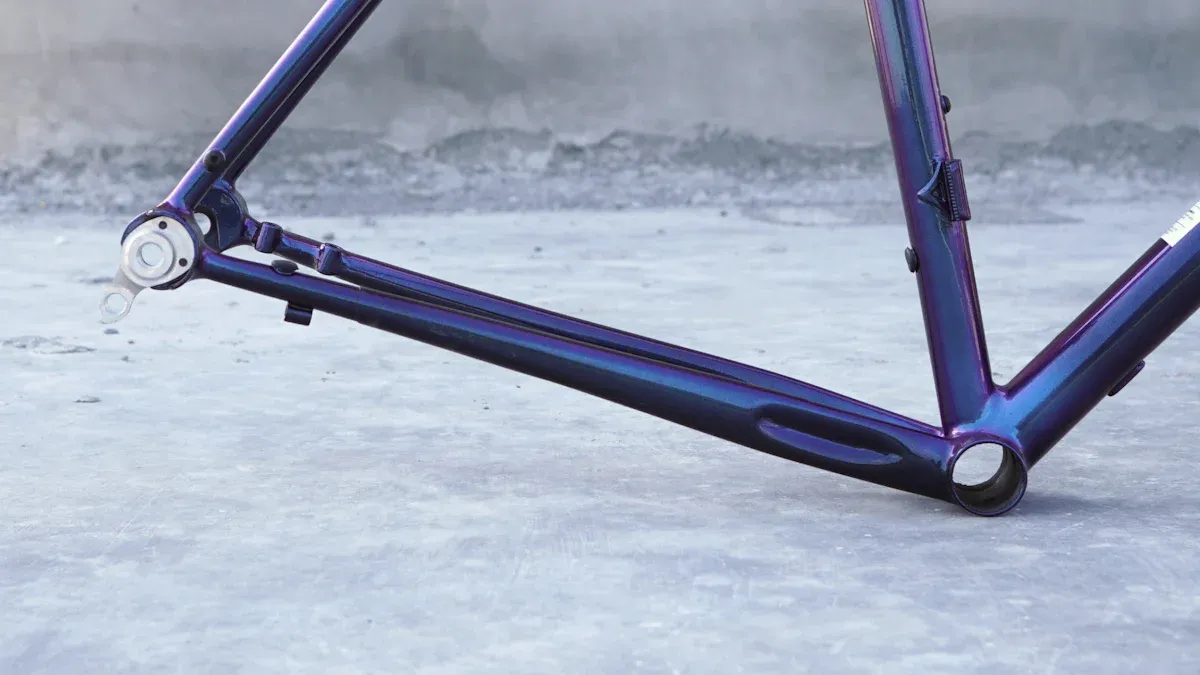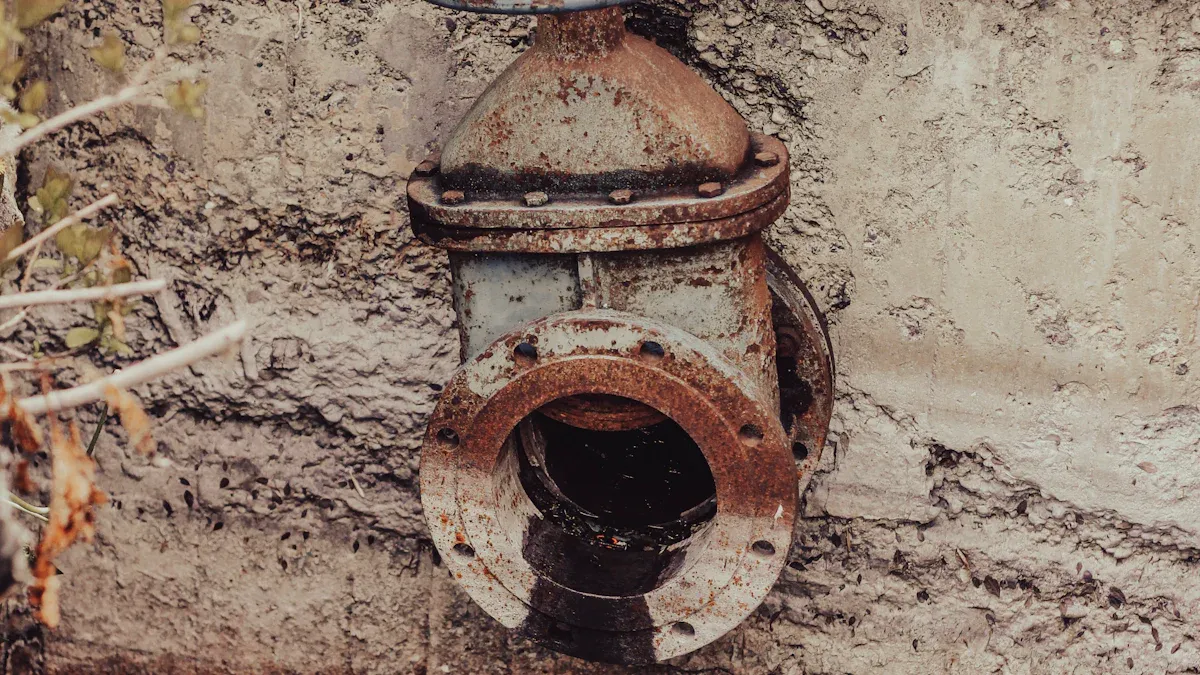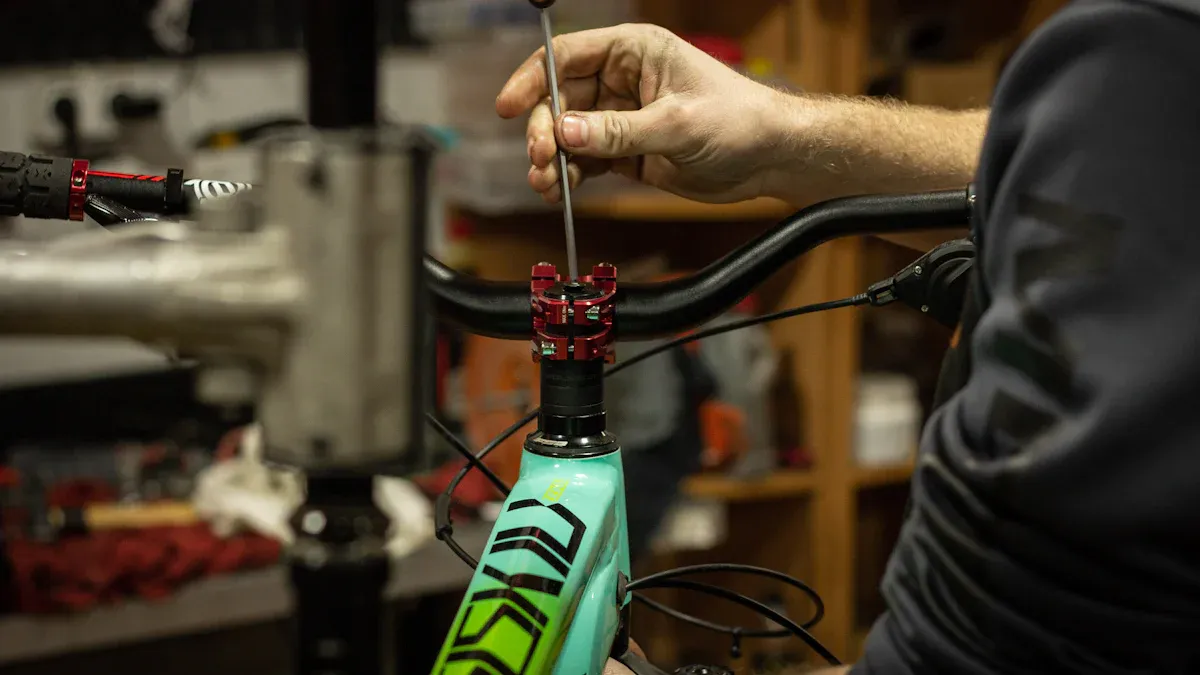
Addressing internal rust in your steel bike frame is important. Ignoring this issue can cause serious problems and weaken the frame. Steel bike frames that are taken care of usually last longer than aluminum ones. Good treatments and prevention steps can help keep your bike strong and working well.
Key Takeaways
Use protective sprays like Frame Saver or Boeshield T9 often. This helps stop internal rust.
Keep your bike in a dry area. This lowers the chance of rust from moisture.
Check your bike frame for rust. Look closely at joints and welds to find problems early.
Understanding Internal Rust

Causes of Internal Rust
Internal rust in your steel bike frame often comes from different environmental factors. Here are some common causes:
Contact with humid air or water: Moisture can easily cause rust if your frame is wet.
Exposure to road salt: This speeds up rust, especially in winter when salt is on roads.
Interaction with saltwater air: If you live near the coast, salty air can cause rust.
Corrosion happens when chemical reactions occur between steel and its environment. This process involves an exchange of atoms, especially when moisture and harmful agents get through protective layers. Once moisture gets inside, it can cause serious damage from the inside.
Signs of Internal Rust
Finding internal rust early can help you avoid expensive repairs. Look for these signs:
The frame may not show rust right away, but check all joints and welds for cracks or weakness. Make sure they stay strong.
Internal rust often grows without being noticed. If you ride your bike in bad weather a lot, rust can move toward the paint. Pay close attention to joints on older frames, as these spots are more likely to get rust damage.
To check for internal rust, look inside the head tube and through the bottom bracket and seat post. Use a flashlight to see any signs of rust or erosion. Finding it early is key to keeping your steel bike frame strong.
Treatments for Internal Rust

You have many good ways to treat internal rust in your steel bike frame. Each method has different costs, effectiveness, and how easy they are to use. Here are some popular treatments:
Using FrameSaver and Boeshield T9
FrameSaver and Boeshield T9 are two popular products for fighting internal rust.
FrameSaver: This product is known for preventing rust for a long time. It makes a protective layer inside your bike frame. Users say it treats existing rust and stops new rust from forming. To use FrameSaver, do these steps:
Take out the seatpost, bottom bracket, and fork.
Block the top and bottom holes of the head tube with paper towels.
Spray about four seconds of FrameSaver into the top tube from the seat-tube hole.
Turn the bike to coat it evenly.
Boeshield T9: This option costs a bit more but gives good protection, especially in wet places. It works like FrameSaver but may not last as long inside. Always wear safety glasses and gloves when using Boeshield T9.
Both products work well, but FrameSaver usually gives better long-term protection against steel bike frame internal rust.
Electrolysis Method
The electrolysis method is another way to treat rust. This method uses electricity to remove rust. However, it has some limits. For it to work well, both electrodes must touch the rust inside the tubes. Users see bubbles during the process, which shows a reaction. But this does not mean all rust is gone. The surfaces need to touch the other electrode, which can be hard in bike frames.
To do electrolysis, you will need:
Equipment | Description |
|---|---|
Battery Charger | Connects to the rusted piece and another metal object to provide current. |
Electrodes | Conductive materials that help the electrolysis process. |
Electrolyte Solution | A mix of baking soda or washing soda in water to help conductivity. |
Container | Holds the bike frame and electrolyte solution during the process. |
Budget-Friendly Solutions
If you want cheaper treatments, some household products can help. They may not work as well as store-bought products, but they can still protect. Here are a few options:
Product | Description | Cost Estimate |
|---|---|---|
Woolwax | Used for truck frames; effective but messier than other options. | More expensive |
KBS Cavity Coater | Automotive product with a spray wand for easy use. | N/A |
AMSOIL MP-HD | Cheap and easy to use; good for important areas. | $25 AUD/can |
Fluid Film | Works well but has a strong smell; thicker texture. | N/A |
Boeshield T9 | Good in wet places; often used. | N/A |
Boiled Linseed Oil | Planned for future use; works like other products. | N/A |
LPS #3 | Similar to Boeshield T9; suggested by a user. | N/A |
While cheaper options like linseed oil or motor oil can help with rust, they usually do not work as well as special products like FrameSaver.
Preventing Steel Bike Frame Internal Rust
Regular Maintenance Tips
To keep your steel bike frame from getting internal rust, you need to do regular maintenance. Here are some tips from experts:
Use a rust blocker like Frame Saver™ or Boeshield T-9™ at least once each season. If you ride in wet weather, use it more often.
After riding in the rain, take out the seat post and turn the bike upside down overnight. This helps any water inside to drain out.
Check your frame often for paint chips. Fix them with touch-up paint to stop moisture from getting in.
At the end of each riding season, take your bike apart. Put on rust blocker and grease all parts to keep them safe.
Look at your steel bike frame once a year under normal conditions. If you live in tough places, like areas with road salt or near the ocean, check and treat your frame twice a year or as needed.
Proper Storage Techniques
How you store your bike can really affect how much internal rust it gets. Follow these storage tips to keep your bike safe:
Keep your bike in a dry place to stop moisture from building up.
Use a weatherproof cover to protect it from rain, snow, and humidity.
Don’t store your bike where temperatures change a lot. Warm air inside the frame can cool down and pull in damp air, which can cause rust over time.
To protect your bike even more, think about these extra steps:
Make sure the bike is clean and dry before you store it.
Use Frame Saver to coat the inside of the bike frame.
Make sure it’s covered well to avoid moisture build-up.
Applying Protective Coatings
Putting on protective coatings is very important to stop internal rust in your steel bike frame. One good choice is the Eastwood Internal Frame Coating. This product gets rid of hidden rust and has a special formula that stops and kills existing rust. Its nozzle lets it go deep into the frame for full coverage.
You can also use anti-corrosion sprays like Boeshield T-9 or WD-40 Specialist Corrosion Inhibitor inside your steel frame every year. Focus on drain holes and inside tubes for the best protection. Also, think about using frame protectors (helicopter tape) on areas that get hit a lot, like the chainstay and downtube.
By following these maintenance tips, storage methods, and using protective coatings, you can greatly lower the chance of internal rust in your steel bike frame. Taking these steps will help your bike last longer.
Tools for Treatment
Recommended Cleaning Tools
To fight internal rust well, you need the right cleaning tools. Here’s a list of helpful tools and what they do:
Tool/Material | Purpose/Effectiveness |
|---|---|
Wire brush | Great for scrubbing off loose rust. |
Sandpaper | Helps smooth and clean rusty surfaces. |
Rust converter | Changes rust into a protective layer. |
WD-40 or similar lubricant | Helps loosen rusted parts. |
Soft cloth or sponge | For applying cleaning solutions. |
White vinegar or lemon juice | Good natural rust removers. |
Baking soda | Good for making a rust-cleaning paste. |
Rust-resistant primer | Protects the metal after cleaning. |
High-quality bike wax/oil | Creates a barrier against future rust. |
Microfibre cloth | Ensures a thorough and gentle application of cleaners. |
Using these tools the right way can really help. For example, scrub rusty areas with a wire brush. Then, use a rust converter to change the rust into a stable layer. Finish by using a rust-resistant primer to protect the surface.
Rust Inhibitors and Converters
Rust inhibitors and converters are very important for stopping future rust. Here are some good products:
Product/Method | Description |
|---|---|
Lock-tite Extend Rust Neutralizer | A spray that treats rust inside steel bike frames well. |
Rust converter (general) | Changes rust into a stable substance that can act as a primer before painting. |
Evapo-Rust | A product used inside to treat rust, followed by a rust inhibitor (Frame Saver). |
Bar Keeper’s Friend | A gentle rust remover that is acidic and works well for removing corrosion. |
Ospho or Corroseal | Rust converters that stop rusting and provide a base to prevent more rust. |
Use these products as the label says. For example, spray Lock-tite Extend directly onto rusty areas and let it soak in.
Maintenance Supplies
Regular maintenance is key to keeping your bike frame rust-free. Here’s a summary of important maintenance supplies:
Material | Maintenance Frequency | Common Issues | Additional Notes |
|---|---|---|---|
Steel | Every 3-5 years | Rust if unprotected | Needs protective coatings for long life. |
Steel frames can last over 50 years if you take care of them. Regular checks and timely use of rust inhibitors can stop damage. Always check your bike after riding in wet weather and apply protective coatings when needed.
By using the right tools and products, you can treat and stop internal rust in your steel bike frame effectively.
To keep your steel bike frame safe from internal rust, focus on regular care and quick treatments. Here are some important tips:
Use protective coatings like Frame Saver every year.
Keep your bike inside in a dry place.
Doing these things will help you keep your bike strong and valuable. 🚴♂️
FAQ
What should I do if I find rust inside my bike frame?
If you see rust, fix it right away. Use products like FrameSaver or Boeshield T9 to stop more damage.
How often should I apply rust inhibitors?
You should use rust inhibitors at least once each season. Use them more often if you ride in wet or salty areas.
Can I prevent internal rust by storing my bike indoors?
Yes, keeping your bike inside a dry place really helps lower the chance of internal rust forming.
See Also
Proven Methods to Eliminate Rust From Your Bicycle Frame
Essential Tips for Caring for Your Steel Bicycle Frame
Easy Strategies to Safeguard Your Bicycle Frame
